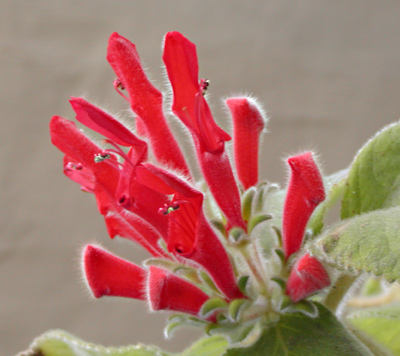
| Species list |
Hybrids list |
Tubers list |
Topics list |
Site index |
What's new |
Home page |
Sinningia hatschbachii is distinctive for bearing bright red flowers in winter. For the grower, this can be an asset. The fuzzy foliage is also attractive. When the leaves develop in the spring and the flowerbuds in the fall, they are covered with handsome fuzz.
For someone growing for show, the blooming season is a severe handicap. Retaining good foliage until winter is also difficult. If the plant is grown outdoors, cold weather may destroy the buds before they open. Even so, this is a popular and attractive species.

|
Sinningia hatschbachii has one of the most distinctive tubers (see a picture). Once you have seen one, it is easy to recognize the tuber from then on, due to its color. Most sinningia tubers are brown or tan or beige, but those of S. hatschbachii are a rich beet red. Sinningia hatschbachii is one of the "Galea Group", a cluster of closely related species which all have flowers with an overhanging upper lip, formed by the two uppermost corolla lobes. Leaf hairinessThis picture shows the hairiness of the leaves of this species, which would make it a good parent for hybrids -- except for one little problem. It's not easy to get S. hatschbachii to bloom at the same time as other sinningia species. |
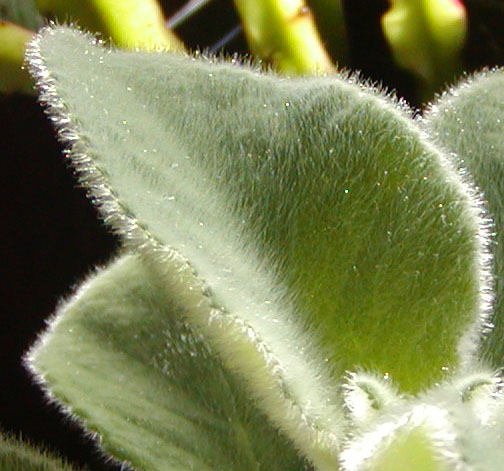
|
Blooming SeasonSinningia hatschbachii has "determinate growth" -- that is, it has a fixed number of leaf pairs and then blooms from the end of the stem. In my conditions, if often has its allotted leaves by mid-summer, and therefore starts making flowerbuds. "Oh great, it will be blooming any day now," one thinks. Not so. Time goes by and those buds just sit there, maybe getting a little bit larger. More time goes by. If the plant gets too dry, the buds dry up. |
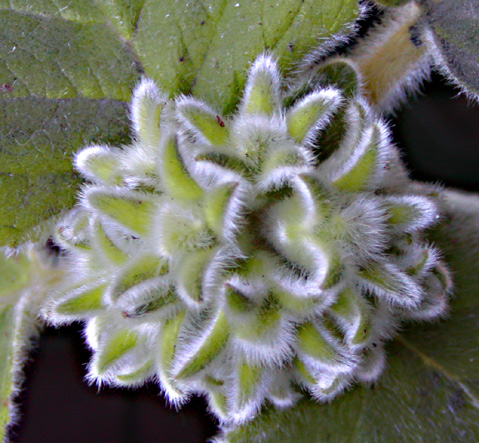
|
|
The plant is waiting for late autumn or early winter, when (perhaps) its hummingbird of choice arrives in its habitat area, or (more likely) all the other sinningias in the area are out of bloom, so there's no chance of hybridization and no competition for pollinator services. This late-autumn blooming strategy probably serves for reproductive isolation, thus keeping the species distinct. But it's a pain in the butt for the outdoor grower in an area which gets winter freezes. It's always a race between hatschbachii's timetable and the weather. Will the flowers open before the cold can kill them? Some years yes, some years no. For the winter of 2006-2007, the answer was no -- see the picture. |
Stigma |
|
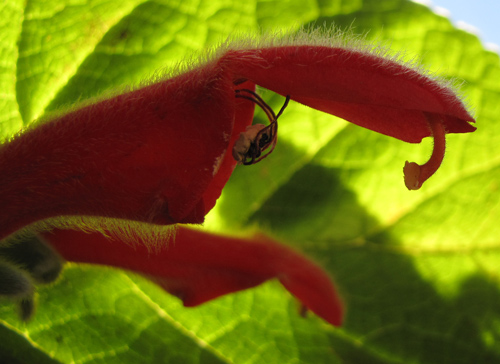
|
This species has an unusual stigma position. The stigma curves through an angle of 180 degrees to face the base of the flower. Presumably it is oriented this way to pick up pollen from the back of the hummingbird's head. The anthers also face the base of the flower, presumably to deposit their pollen on the back of the bird's head. One little puzzle: as pointed out by Alain Chautems, the filaments (anther stalks) are shorter than the style. |
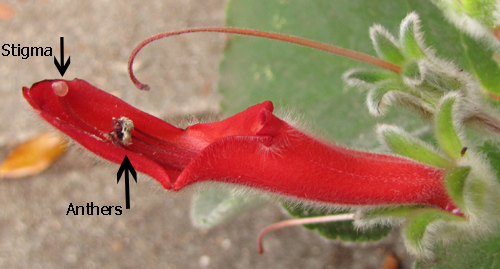
|
One flower obligingly flipped onto its back, to expose the relative positions of the stigma and the anthers. |
In HabitatOn the Gesneriad Research Foundation trip in 1999, we saw S. hatschbachii growing on steep roadside banks. Since this was in Brazilian autumn, several plants were in bloom. Rains had detached a few of the tubers from the bank and washed them down the hill. HybridizationI have crossed S. hatschbachii with S. glazioviana, because both of them bloom in winter in my yard. The resulting plant is nice enough, but not a particular improvement on either of the parents. Ingrid Lindskog crossed this species with S. leucotricha, which would seem like a natural if you could get the two hairy species to bloom at the same time, and with S. lineata. The last I heard, they had not bloomed for her. Selfing the leucotricha cross would seem like one of the best bets for getting a galeate flower on leucotricha-type foliage. |
| Plant Description |
|
| Growth | Determinate |
| Habit | Stems upright or spreading (if more than one). |
| Leaves | Green, very fuzzy. Three-four pairs. See a above for a closeup. |
| Dormancy | Stems deciduous. Dormancy appears obligate. Tuber is dark red. |
Flowering |
|
| Inflorescence | terminal cluster |
| Season | Blooms in autumn, winter |
| Flower | Red, tubular, with galea |
Horticultural aspects |
|
| Hardiness | 30 F (-1 C) killed the leaves of a plant in my yard, just as it was preparing to bloom [December 2006], but the leaves were not harmed by 32 F (0 C). |
| Recommended? | Yes, definitely, if you have the climate for it. S. hatschbachii is like S. cardinalis, but with really nice hairy leaves, a big beet-red tuber, and a compact growth habit. The only downside is that it blooms late in the fall, so it's not good for outdoor growing in places with frosty Novembers (or Mays, in the southern hemisphere). On the other hand, the downside is also a plus. This species provides a great splash of color on gray winter days. |
Hybridization |
|
| Hybrids with this species | See listing. |
| Why so few? | Blooms in mid-winter |
Botany |
|
| Taxonomic group | The galea group of the Dircaea clade. |
Chautems 1997.